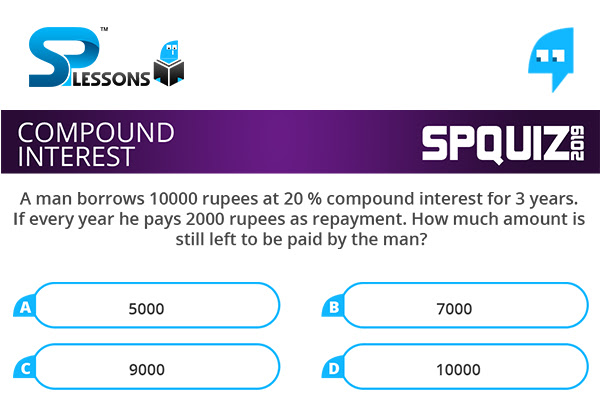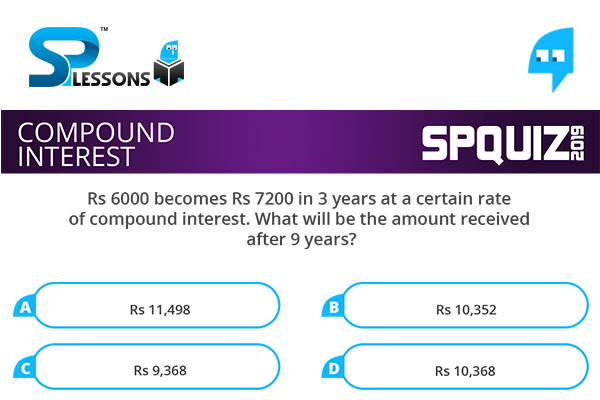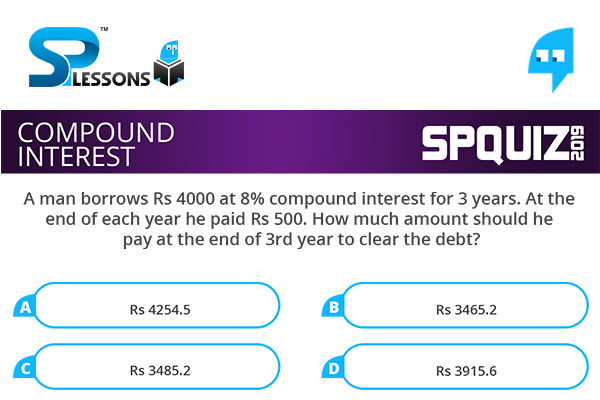 Introduction
Introduction
What is compound interest?
Compound interest is the addition of interest to the principal sum of a loan or deposit, or in other words, interest on interest. It is the result of reinvesting interest, rather than paying it out, so that interest in the next period is then earned on the principal sum plus previously accumulated interest.
Compound Interest is one of important topic in Quantitative Aptitude Section. In Compound Interest Quiz 8 article candidates can find questions with answer. By solving this questions candidates can improve and maintain, speed, and accuracy in the exams. Compound Interest Quiz 8 questions are very useful for different exams such as IBPS PO, Clerk, SSC CGL, SBI PO, NIACL Assistant, NICL AO, IBPS SO, RRB, Railways, Civil Services etc.
 Q1
Q1
Priya saves an amount of 500 every year and then lent that amount at an interest of 10 percent compounded annually. Find the amount after 3 years.
- A. 1820.5
B. 1840.5
C. 1920.5
D. 1940.5
Total amount [latex]= 500 \times {(1 + \frac {10}{100})}^{3} + 500 \times {(1 + \frac {10}{100})}^{2} + 500 \times (1 + \frac {10}{100})[/latex] = 1820.5
 Q2
Q2
A man borrows 10000 rupees at 20 % compound interest for 3 years. If every year he pays 2000 rupees as repayment. How much amount is still left to be paid by the man?
- A. 5000
B. 7000
C. 9000
D. 10000
Amount to be paid at the end of three years = [latex]10000 \times {(1 + \frac {20}{100})}^{3} = 17280[/latex]
Amount paid as installment by the man = [latex]2000 \times {(1 + \frac {20}{100})}^{2} + 2000 \times (1 + \frac {20}{100}) + 2000 = 7280[/latex]
So remaining amount = 10000
 Q3
Q3
On a certain sum of money, after 2 years the simple interest and compound interest obtained are Rs 800 and Rs 960 respectively. What is the sum of money invested?
- A. Rs 1420
B. Rs 1325
C. Rs 1000
D. Rs 1405
Diff = 960 - 800 = 160
r = [latex] 2 \times Diff \times \frac {100}{SI}[/latex]
So r = [latex] 2 \times 160 \times \frac {100}{800} = 40%[/latex]
Now 160 = [latex] \frac {P{r}^{2}}{{100}^{2}} [/latex] = Rs 1000
 Q4
Q4
Rs 6000 becomes Rs 7200 in 3 years at a certain rate of compound interest. What will be the amount received after 9 years?
- A. Rs 11,498
B. Rs 10,352
C. Rs 9,368
D. Rs 10,368
[latex] 6000 {[1 + \frac {r}{100}]}^{3} = 7200[/latex]
So [latex] {[1 + \frac {r}{100}]}^{3} = \frac {6}{5} [/latex]
So [latex] 6000 {[1 + \frac {r}{100}]}^{9} = 6000 \times (\frac {6}{5}) \times (\frac {6}{5}) \times (\frac {6}{5})[/latex] = Rs 10,368
 Q5
Q5
A man borrows Rs 4000 at 8% compound interest for 3 years. At the end of each year he paid Rs 500. How much amount should he pay at the end of 3rd year to clear the debt?
- A. Rs 4254.5
B. Rs 3465.2
C. Rs 3485.2
D. Rs 3915.6
Amount after 1 yr = [latex]4000[1 + \frac {8}{100}] = 4320[/latex]
Paid 500, so P = 4320 – 500 = 3820
Amount after 2nd yr = [latex] 3820[1 + \frac {8}{100}] = 4125.6[/latex]
So P = 4125.6 - 500 = 3625.6
Amount after 3rd yr = [latex]3625.6[1 + \frac {8}{100}] = 3915.6[/latex]








